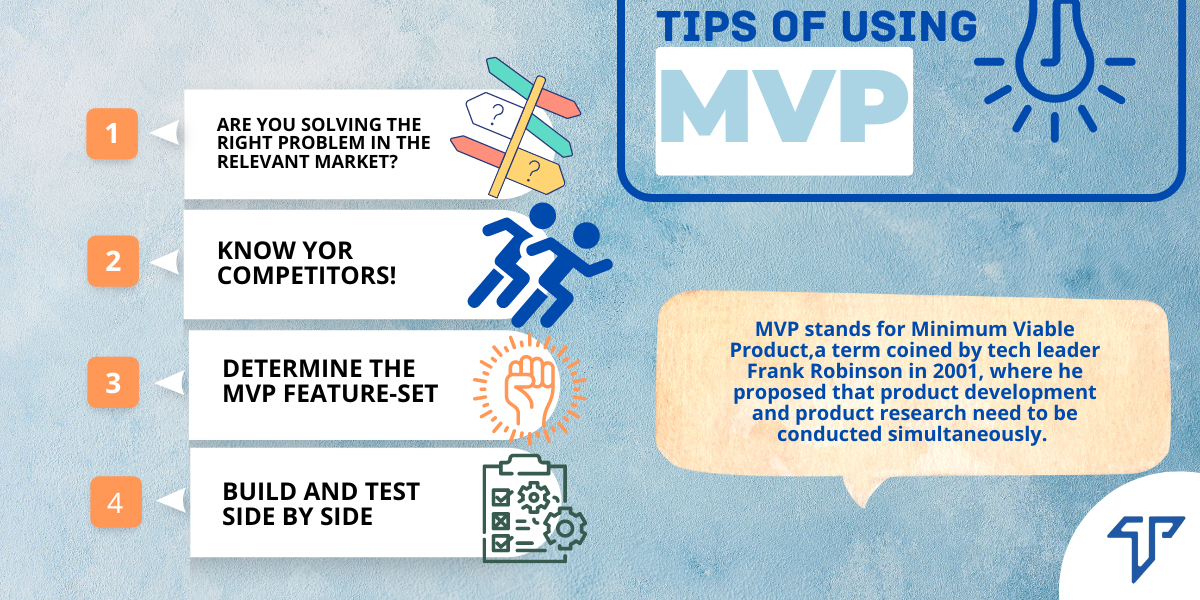Minimum Viable Product: What It Is and How to Create One

Do you have a BIG IDEA that you want to turn into a successful business? Have you been thinking of joining the startup bandwagon, but don’t know where to start? If you’re serious about turning your idea into a reality that has the potential to make money as well, the MVP approach is your best bet. We’ll be exploring options for a solution for you right here. If you’re starting a business, and you want to do it fast and do it well, an efficient MVP (Minimum Viable Product) should be on top of your To-Do List.
Below you’ll get to know all about an MVP, its importance for your business, and some essential tips to help you create it successfully.
What does an MVP mean?
Before diving into the real solutions of the ideal MVP, it is essential to know what an MVP is. MVP stands for Minimum Viable Product,a term coined by tech leader Frank Robinson in 2001, where he proposed that product development and product research need to be conducted simultaneously.
In simple words, it is a smart method of making your product reach your audiences, before a full-fledged large scale launch.
Consider this:
You’re a creative go-getter and you want to kick start your dream venture.You conduct your market research and plan to solve your potential customers’ problems through your product. Naturally, you would want to launch a product that is fully functioning, and covers all your customer pain points.
But no matter how good you think your product is, you can never be sure of its success. Your product cannot be perfect the first time you create it.
The best approach to launching your product is to have your product in the hands of your customers and make them use it in real time. Once they start using it, they can provide you REAL and valuable feedback. You can then incorporate the feedback into your product design to make frequent, incremental improvements.
This initial free-standing product that you launch is called your MVP. With a minimum number of features, it just solves the single most important problem it’s supposed to address. However, it should really solve the problem well in order to receive actionable responses from early adopters. The subsequent changes you make in the product based on feedback are called iterations.
Why is an MVP important for your business?

According to Forbes, 90% of the total new businesses found every year fail.
CB Insights claim that 35% of the startups fail because of their inability to read market demand.
In other words, most startups go kaput because their product does not ACTUALLY solve a problem for the consumers. In simple words, Nobody Wants Their Product.
An MVP as opposed to a full blown product built upon the top down waterfall approach is truly empowering for the founders. Instead of developing the entire thing before realizing if the customers need it, find it easy or are willing to pay for it, the MVP delivers the core functionality with minimal resources. However, as simple as it sounds, creating an MVP is not a walk in the park.
Eric Ries proposed an alternative to the waterfall method of product development in his book “The Lean Startup”. He described the MVP as that version of a new product which allows a team to collect the maximum amount of validated learning about customers with the least effort.
Through the Build-Measure-Learn approach of agile development, businesses get to develop a basic product with the minimum features required for it to work. It helps them gain feedback from actual users in real time before it is officially launched in the market, in other words making customer research and product development work in tandem.
It is an efficient technique to test out potential business ideas and get a glimpse of how this new product or idea will perform in the long run.. But the possibility of a start-up succeeding is always there. The MVP can help you gain sufficient insights into the market before you go all in. It helps you reduce development costs as well.
An important point to remember though is that the MVP is not supposed to start making money. It’s actually developed to help understand how to create a process or system to make money.
Developing Your MVP
Your MVP will be a very important part of your start-up. Therefore, you must take your time thoroughly planning how to create your MVP. Underneath, you will find the essential tips to help you achieve it.
It’s very difficult to chalk out the exact functionalities that make an MVP; it’s a fine balance between “not enough” and “too much”. It’s about prioritizing the most essential features that solve the problem at hand efficiently and effectively. This could take time and expertise in lean and agile development methodologies.
Here are four tips you need to keep in mind, when you go for an MVP.
Tip 1: Are you Solving The Right Problem in the Relevant Market?
As Kobe Bryant said, “If you do not believe in yourself, no one else will.” When you have decided to come up with a product that you want your start-up to be based around, it is highly important that you understand its basic need and value. You need to believe in your product before expecting anyone else to.
For that you need to ask the right questions, such as:
Is there a real problem here?
What is the problem not being addressed or not being solved efficiently?
Who has the problem? Are they aware of the problem? Do they know the true value of the solution, in terms of the time or money it could save?
Have they or anybody else tried to solve it?
Why would anyone need this? Does it actually solve a pain point for potential customers?
Have they been using other solutions? If so, are they satisfied with them?
Are they willing to pay for your solution? If so, how much?
Understand first the value your product holds in terms of its ability to respond to the needs of its market. You also need to see the potential of your product in realistic terms. You should be open-mindedly able to assess the utility of your product. Once you eliminate ideas that aren’t practical enough, you can create space for better ideas.
Tip 2: Know Your Competitors
Conducting a thorough competitive analysis is imperative for understanding your target market. Your competition is your source for understanding what has worked earlier for your target audiences and what hasn’t. You can identify the shortfalls as well as winning strategies of the already existing products catering to your market. This gives you an opportunity to analyze the pros and cons of other players in the industry. Hence, this way you can steer clear of some of the threats your competitors are facing and devise a strategy based on insights from their experiences.
Tip 3: Determine the MVP feature-set
The MVP feature set is of utmost significance. You have to decide the core functionality of your product, and prioritize what matters the most in solving the problem at hand.
This is where you need to understand your user journey or user flow, by identifying all the steps your users undergo throughout the process. Once you identify the steps, you can put labels on each step to help streamline the process. Each step is called an ‘epic’, as referred to in the agile development approach. While technically an epic can involve multiple teams and projects, it is a simple way to start and organize all your work.
Now, come the features. You can represent each feature with a ‘user story’. The user story determines the ‘what’, ‘why’ and ‘when’ of user needs. It can be divided into several tasks and subtasks that can be allocated to different members of the development team.
It is okay to include more than one feature in each story.
Once the epics and user stories have been identified, they can be then arranged in order, based on their significance and urgency. These are then arranged on a time schedule following the logical order of their development. The key is to realize what brings value to the business, the feature that needs to be developed first, in order to support future features, and which step is inevitable for the process to succeed.
Tip 4: Build And Test Side-by-side
With the epics and user stories, the scope of work has been adequately addressed and described. Agile development in the Lean approach signifies that the items prioritized for immediate development are completely described. However, the items that need to be built in the future are taken up for description just before they are needed. This allows the use of the most up-to-date and thorough information available.
This way you can avoid shooting in the dark and make informed choices based on the latest and most relevant information.
Regular testing is a crucial part of MVP development. This way, your product becomes more sound and technically sustainable as new features are added to it.You need to go through all the three steps of testing; alpha testing (by the employees working in the product) , beta testing (by some early users and employees not working on the product) and feedback testing (by some external auditors or select early adopters), for your MVP to hold ground.
Out of these three, feedback testing is extremely important as it can help validate that
- The product solves an actual problem
- It does so better than its competition
- The users are willing to pay for the solution and recommend it to others too.
Note that testing is iterative; helping identify improvements to the functionality while bringing the users closer to the most optimum solution.
An article published in Forbes (2015) mentioned the qualities of successful startups, “They have a product that meets a need, they don’t ignore anything, they grow fast, and they recover from the hard-knock startup life.”
The Final Word
Before you do a final check of your MVP, remember that your MVP does not necessarily have to be perfect or exactly like the final product. Your MVP is a way of organizing your business plan and seeing how your product may stand in the competitive world of other similar products. You will have to see if your product ticks off the requirements of your target audience. Go through your to-do list and see if you have covered all the tasks and are done with the basics. Do one final check and be prepared to work on launching your MVP.
Setting up a new business can be a rocky road at times but remember, if you believe in your idea and the potential it holds in realistic terms, don’t waver in your faith. You have all it takes to build something successful from scratch. Building an MVP is your first step towards success. Even if you fail the first time, there is always the next time. The founder and CEO of Zappos, Tony Hsieh, advised, “Chase the vision, not the money; the money will end up following you.”
Contact Techtiz to learn more!
All the best!







